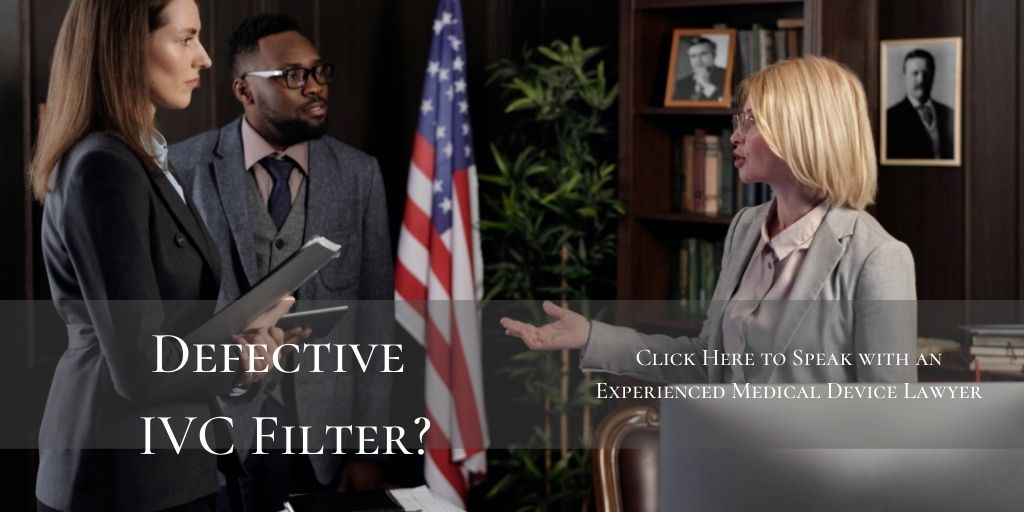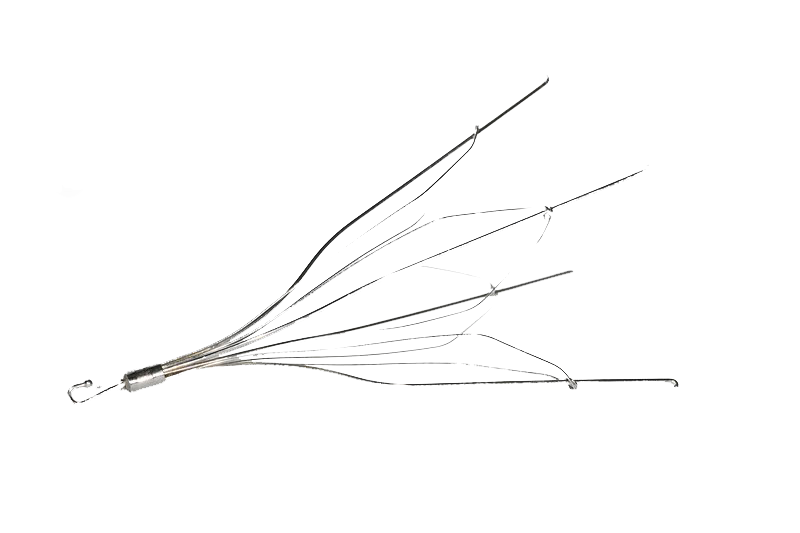Last Updated December 3, 2020
Deep Vein Thrombosis (DVT) or blood clots that form in the large veins of the lower extremities sometimes progress to the point where they cause swelling, tenderness, and pain in patients. When DVTs break loose and travel through the body on the way back to the heart they become a potentially life-threatening risk in the form of a Pulmonary Embolism (PE). The frontline treatment for DVT is usually a prescription blood-thinner on either a temporary or permanent basis. However, where blood thinners are not an option, doctors may recommend the placement of an Inferior Vena Cava (IVC) filter as a solution.
As with any surgical procedure, implantation with an IVC filter presents a number of risks and benefits to patients. It is important that patients discuss the facts about IVC filters with their physicians and learn as much as possible about the risks and potential complications from these devices. Below are some of the more commonly asked questions about IVC filters which can form the basis for a broader conversation with your physician about DVT treatments and a comprehensive IVC filter strategy.
What is an Inferior Vena Cava (IVC) Filter?
IVC filters are small mechanical devices that surgeons place into the vein in order to prevent DVT and other types of blood clots from using the IVC as a highway back to the heart and lungs. They are spindly devices that look and act like a sifter – allowing clear blood components to pass through it while intercepting and catching clots.
Which Patients Typically Receive IVC Filters?
IVC filters are generally recommended for patients who suffer from chronic DVT and who cannot take blood-thinning medication. Sometimes, an IVC filter will be recommended to patients who are about to undergo surgery and have to suspend taking blood thinners temporarily.
Is an IVC Filter Implanted Permanently?
There are two general types of IVC filters on the market in the United States: permanent and optional (also known as “retrievable”). Permanent filters have been utilized in patients since the 1970s and are placed in patients with long-term needs to filter against PE or other issues with blood clotting. Retrievable filters are newer and as the name suggests, are designed to be retrieved from the patient (or sometimes left in place) after a temporary risk of PE or clotting has passed or been resolved.
How are IVC Filters Implanted?
The procedure for implanting an IVC filter typically involves a smaller incision made by an implanting physician in either the groin or neck. The doctor will then insert a flexible tube or “catheter” with a collapsed filter into a vein and route into the Inferior Vena Cava. Once it reaches the IVC, the filter is then triggered to expand and attach itself to the walls of the vein. In some cases, the filter becomes a permanent fixture in the IVC, although others are implanted with the understanding they will be removed after some period of time.
How Should I Prepare for IVC Insertion Procedure?
Prior to the procedure, your physician will likely order a series of blood tests to examine kidney function and blood clotting patterns. You should be very open and tell your physician about all medications – as well as herbal supplements that you take on a regular basis. Also, ensure that your physician is well aware of any recent illnesses or other medical conditions. Your physician will advise you as to which medications you can take either in advance or the day of the procedure as well as whether or not to eat or drink anything after midnight beforehand.
What is the Procedure Like?
IVC insertion is usually performed on an outpatient basis either in an operating room or in an interventional radiology suite. Patients are typically positioned on their back and are connected to a heart monitor. Usually, the procedure does not require general anesthesia and patients can be administered a solution intravenously which induces a sedated state. The physician will numb the insertion site and make a very small incision for catheter insertion. When the procedure is finished, the catheter is removed and pressure is applied to stop bleeding. Stitches are not usually required and a small dressing is applied to the small incision.
When Can Patients Go Home After the IVC Filter Insertion?
The insertion procedure is usually completed within an hour. Patients will remain at the medical center for up to 3-4 hours and then can return home. In some cases, your physician will order you to remain overnight at the hospital for observation.
What Should You Do When You Get Home?
Patients should avoid strenuous activities for at least a day or two. They can resume a normal diet and should consume fluids to avoid dehydration. A bandage should be kept over the incision site for at least a day or as long as your physician recommends. An ice pack can be placed on the site for 10-20 minutes at a time to help alleviate soreness and swelling.
What About Medications?
You should speak at length with your physician about all medications and supplements you are taking. She will let you know when to stop and restart any medication consistent with the procedure. Be safe with your medications and take them precisely as directed by your physician. If you think your medication is making you sick, advise your doctor immediately and discuss options for possible substitution.
Can Things Go Wrong with IVC Filters?
IVC filters have enjoyed widespread adoption and use – in particular following the introduction of optional or retrievable filters in the 1990s. However, with the increased use of the filter, has come a growing recognition that there are a number of safety complications associated with these devices. Some risks and complications associated with IVC filters include:
- IVC Filter Fracture
- IVC Filter Penetration
- IVC Filter Migration
- Excessive Tilting
Patients should have a frank and open discussion with their physicians about the type of device with which they are going to be implanted as well as the risks associated with that particular device.
If I Have a Removable Filter – When Should It Be Removed?
The U.S. Food and Drug Administration (FDA) has issued a recommendation concerning removable IVC filters. Specifically, the FDA believes that removable filters should be removed as soon as the risk of PE has subsided. Guidelines further state that removal should take place within 29-54 days following insertion (if possible).
Sources Cited (15):
1) “IVC Blood Clot Filter Problems and FAQs” https://www.findlaw.com/injury/product-liability/ivc-blood-clot-filter-problems-and-faqs.html
2) “UCLA IVC Filter Clinic: Questions and Answers” https://www.uclahealth.org/radiology/ivc-filter/faqs
3) “Houston Methodist: IVC Frequently Asked Questions” https://www.houstonmethodist.org/1285_houstonmethodist/738_servicesandspecialties/heart-vascular/conditions-treatments/1544a_servicesandspecialities_ivcfilterremoval/1544b_servicesandspecialities_ivcfilterremoval_faqs/
4) “Inferior vena cava filters: debatable benefit; rarely removed” https://pulmccm.org/cardiovascular-disease-review/inferior-vena-cava-filters-placement-often-misguided-unhelpful-rarely-removed-jama-int-med/
5) “Penn Medicine: IVC Filter Removal” https://www.pennmedicine.org/for-patients-and-visitors/find-a-program-or-service/interventional-radiology/ivc-filter-removal
6) “Inferior Vena Cava Filter Placement and Removal” https://www.radiologyinfo.org/en/info.cfm?pg=venacavafilter
7) “Vena Cava Filter Placement: What to Expect at Home” https://myhealth.alberta.ca/Health/aftercareinformation/pages/conditions.aspx?hwid=abo4461&
8) “Inferior Vena Cava Filter” https://www.ncbi.nlm.nih.gov/books/NBK549900/
9) “Permanent versus Retrievable Inferior Vena Cava Filters: Rethinking the “One-Filter-for-All” Approach to Mechanical Thromboembolic Prophylaxis” https://www.ncbi.nlm.nih.gov/pmc/articles/PMC4862850/
10) “FDA Issues Statement on Treatment and Follow-Up Regarding IVC Filter Complications” https://evtoday.com/news/fda-issues-statement-on-treatment-and-follow-up-regarding-ivc-filter-complications
11) “Predicting the Safety and Effectiveness of Inferior Vena Cava Filters” http://www.preservetrial.com/
12) “Vena cava filters” https://www.medicalexpo.com/medical-manufacturer/vena-cava-filter-44592.html
13) “Complications of Inferior Vena Caval Filters” https://www.ncbi.nlm.nih.gov/pmc/articles/PMC3036364/
14) “IVC Filter Migration: How Does It Happen?” https://medium.com/@Drug_Justice/ivc-filter-migration-how-does-it-happen-1e453d77a0af
15) “FDA Updates Safety Communication on IVC Filter Retrieval” https://evtoday.com/news/fda-updates-safety-communication-on-ivc-filter-retrieval



